child restraint MAZDA MODEL MX-5 MIATA PRHT 2012 Owners Manual
[x] Cancel search | Manufacturer: MAZDA, Model Year: 2012, Model line: MODEL MX-5 MIATA PRHT, Model: MAZDA MODEL MX-5 MIATA PRHT 2012Pages: 456, PDF Size: 5.68 MB
Page 5 of 456
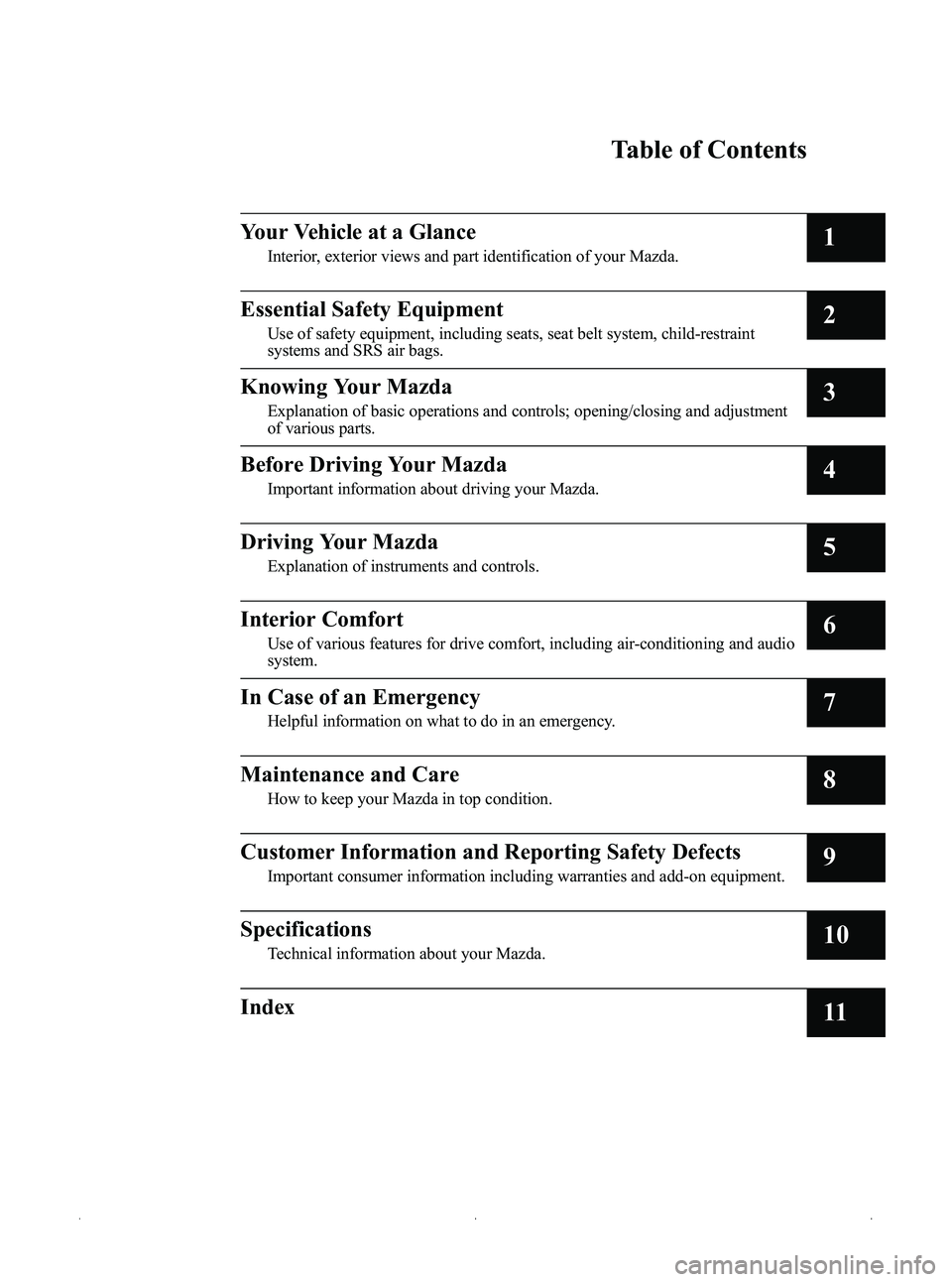
Black plate (5,1)
MX-5_8CC1-EA-11F_Edition2 Page5
Monday, July 18 2011 10:7 AM
Form No.8CC1-EA-11F
Table of Contents
Your Vehicle at a Glance
Interior, exterior views and part identification of your Mazda.1
Essential Safety Equipment
Use of safety equipment, including seats, seat belt system, child-restraint
systems and SRS air bags.2
Knowing Your Mazda
Explanation of basic operations and controls; opening/closing and adjustment
of various parts.3
Before Driving Your Mazda
Important information about driving your Mazda.4
Driving Your Mazda
Explanation of instruments and controls.5
Interior Comfort
Use of various features for drive comfort, including air-conditioning and audio
system.6
In Case of an Emergency
Helpful information on what to do in an emergency.7
Maintenance and Care
How to keep your Mazda in top condition.8
Customer Information and Reporting Safety Defects
Important consumer information including warranties and add-on equipment.9
Specifications
Technical information about your Mazda.10
Index11
Page 13 of 456
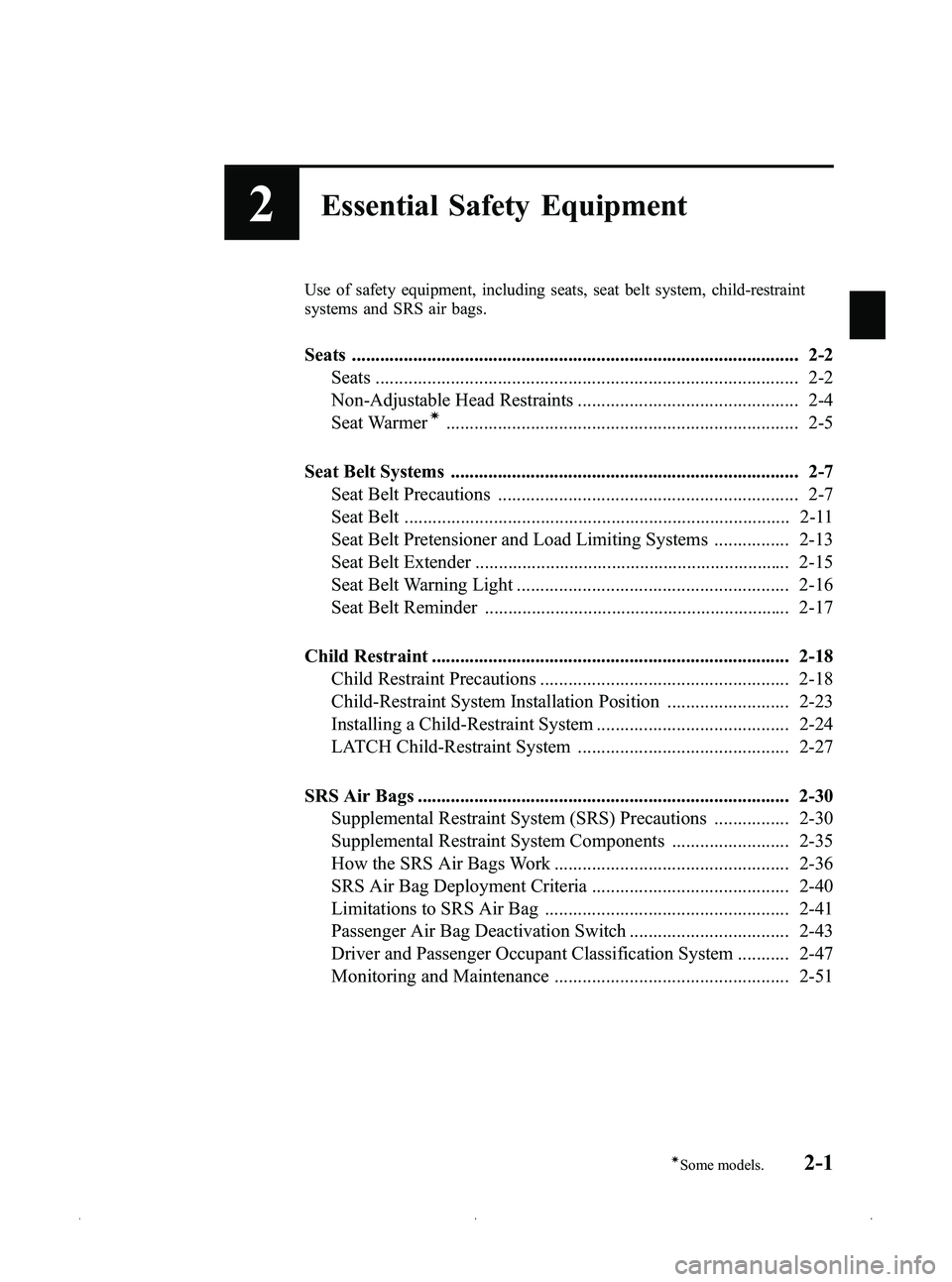
Black plate (13,1)
2Essential Safety Equipment
Use of safety equipment, including seats, seat belt system, child-restraint
systems and SRS air bags.
Seats ............................................................................................... 2-2Seats .......................................................................................... 2-2
Non-Adjustable Head Restraints ............................................... 2-4
Seat Warmer
í........................................................................... 2-5
Seat Belt Systems .......................................................................... 2-7 Seat Belt Precautions ................................................................ 2-7
Seat Belt .................................................................................. 2-11
Seat Belt Pretensioner and Load Limiting Systems ................ 2-13
Seat Belt Extender ................................................................... 2-15
Seat Belt Warning Light .......................................................... 2-16
Seat Belt Reminder ................................................................. 2-17
Child Restraint ............................................................................ 2-18 Child Restraint Precautions ..................................................... 2-18
Child-Restraint System Installation Position .......................... 2-23
Installing a Child-Restraint System ......................................... 2-24
LATCH Child-Restraint System ............................................. 2-27
SRS Air Bags ............................................................................... 2-30 Supplemental Restraint System (SRS) Precautions ................ 2-30
Supplemental Restraint System Components ......................... 2-35
How the SRS Air Bags Work .................................................. 2-36
SRS Air Bag Deployment Criteria .......................................... 2-40
Limitations to SRS Air Bag .................................................... 2-41
Passenger Air Bag Deactivation Switch .................................. 2-43
Driver and Passenger Occupant Classification System ........... 2-47
Monitoring and Maintenance .................................................. 2-51
2-1íSome models.
MX-5_8CC1-EA-11F_Edition2 Page13
Monday, July 18 2011 10:7 AM
Form No.8CC1-EA-11F
Page 19 of 456
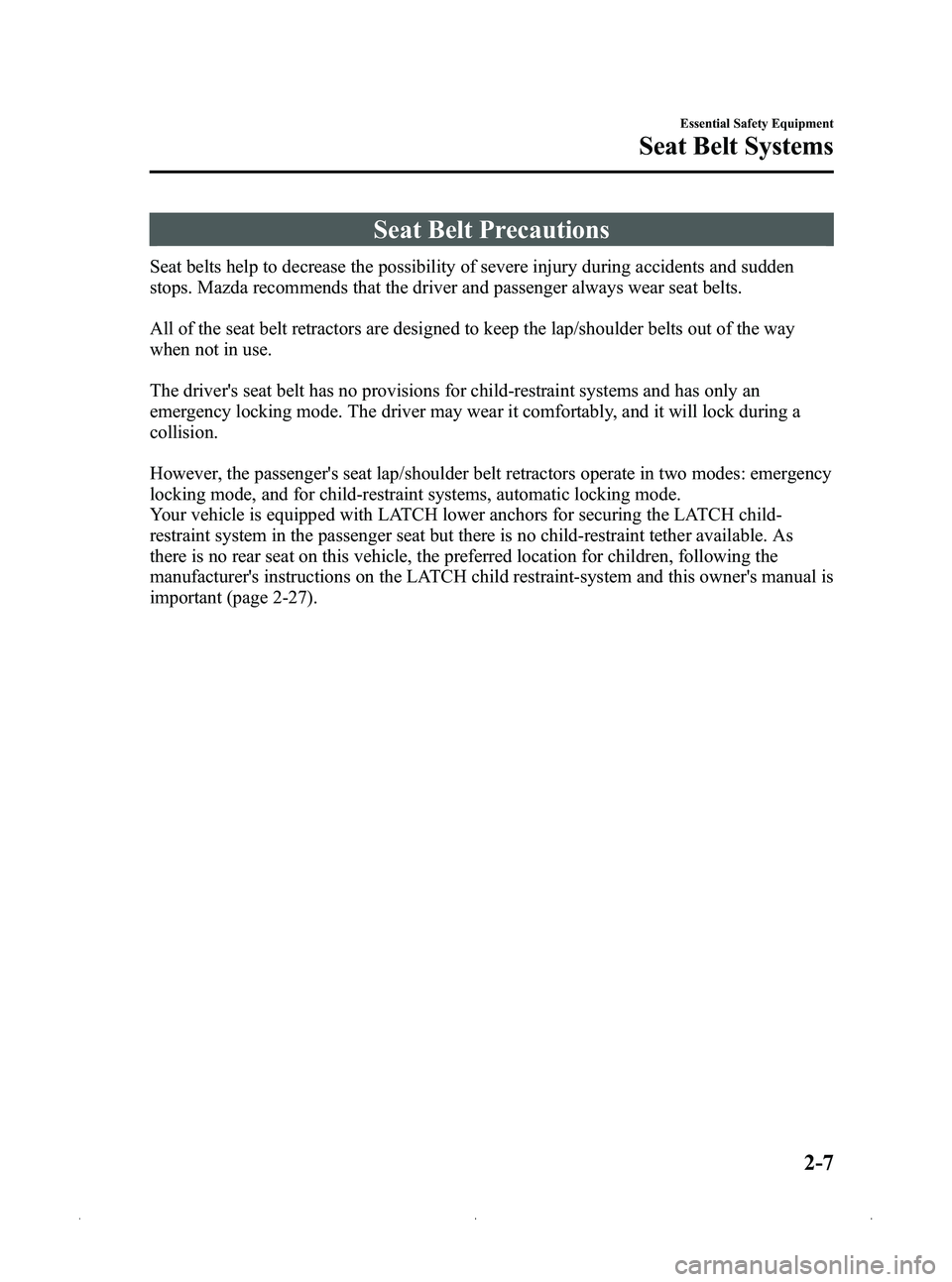
Black plate (19,1)
Seat Belt Precautions
Seat belts help to decrease the possibility of severe injury during accidents and sudden
stops. Mazda recommends that the driver and passenger always wear seat belts.
All of the seat belt retractors are designed to keep the lap/shoulder belts out of the way
when not in use.
The driver's seat belt has no provisions for child-restraint systems and has only an
emergency locking mode. The driver may wear it comfortably, and it will lock during a
collision.
However, the passenger's seat lap/shoulder belt retractors operate in two modes: emergency
locking mode, and for child-restraint systems, automatic locking mode.
Your vehicle is equipped with LATCH lower anchors for securing the LATCH child-
restraint system in the passenger seat but there is no child-restraint tether available. As
there is no rear seat on this vehicle, the preferred location for children, following the
manufacturer's instructions on the LATCH child restraint-system and this owner's manual is
important (page 2-27).
Essential Safety Equipment
Seat Belt Systems
2-7
MX-5_8CC1-EA-11F_Edition2 Page19
Monday, July 18 2011 10:7 AM
Form No.8CC1-EA-11F
Page 22 of 456
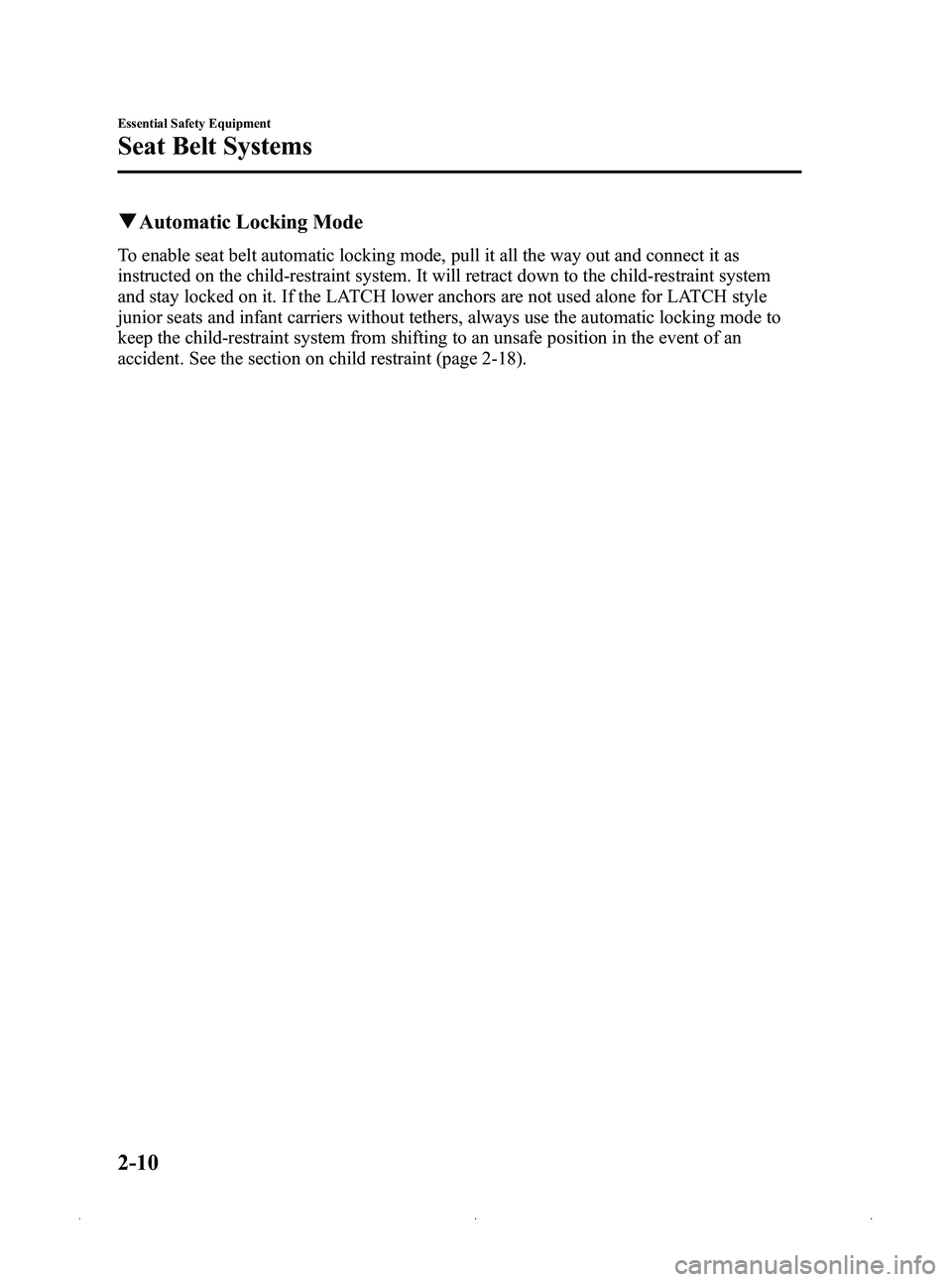
Black plate (22,1)
qAutomatic Locking Mode
To enable seat belt automatic locking mode, pull it all the way out and connect it as
instructed on the child-restraint system. It will retract down to the child-restraint system
and stay locked on it. If the LATCH lower anchors are not used alone for LATCH style
junior seats and infant carriers without tethers, always use the automatic locking mode to
keep the child-restraint system from shifting to an unsafe position in the event of an
accident. See the section on child restraint (page 2-18).
2-10
Essential Safety Equipment
Seat Belt Systems
MX-5_8CC1-EA-11F_Edition2 Page22
Monday, July 18 2011 10:7 AM
Form No.8CC1-EA-11F
Page 28 of 456
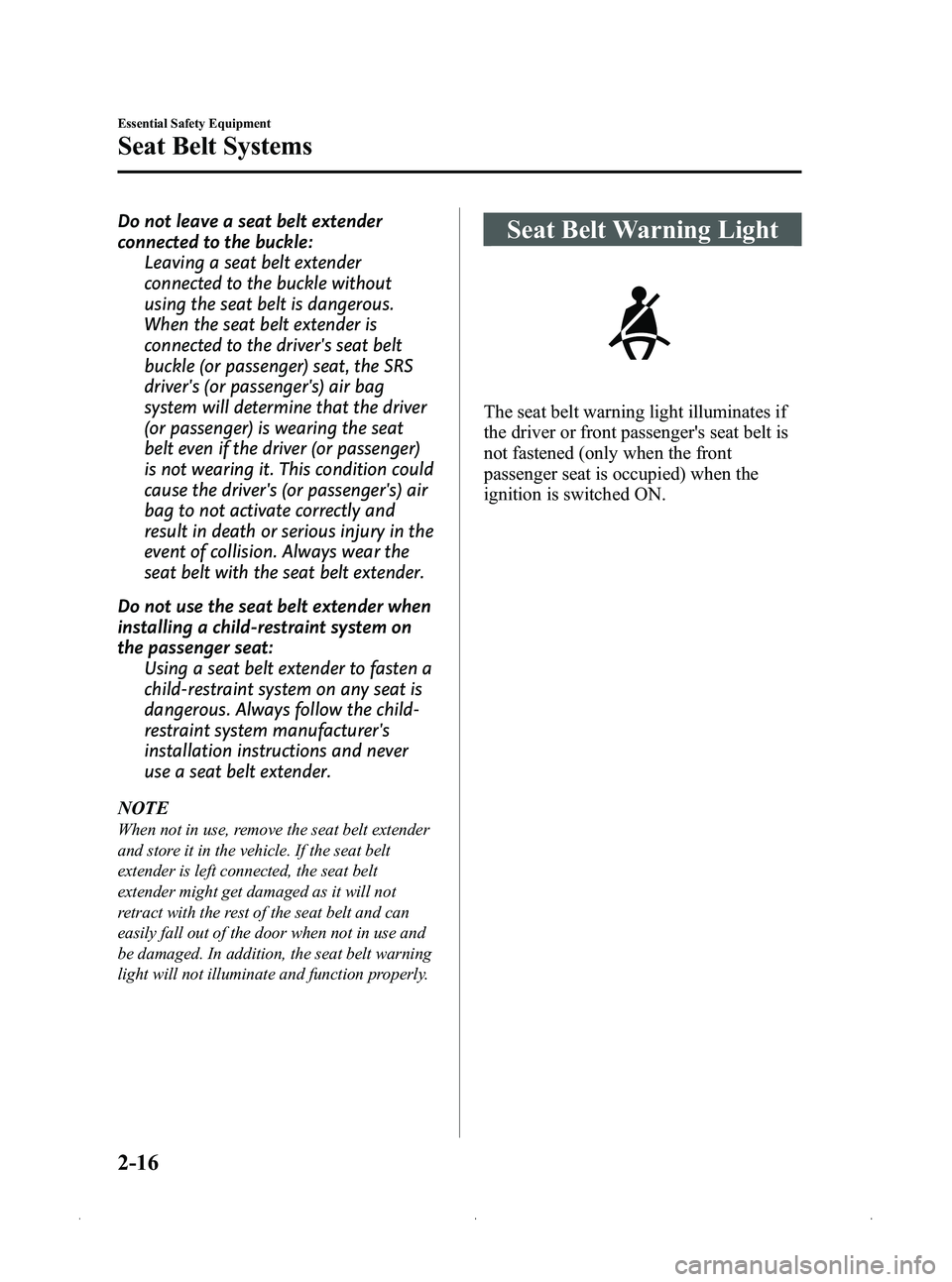
Black plate (28,1)
Do not leave a seat belt extender
connected to the buckle:Leaving a seat belt extender
connected to the buckle without
using the seat belt is dangerous.
When the seat belt extender is
connected to the driver's seat belt
buckle (or passenger) seat, the SRS
driver's (or passenger's) air bag
system will determine that the driver
(or passenger) is wearing the seat
belt even if the driver (or passenger)
is not wearing it. This condition could
cause the driver's (or passenger's) air
bag to not activate correctly and
result in death or serious injury in the
event of collision. Always wear the
seat belt with the seat belt extender.
Do not use the seat belt extender when
installing a child-restraint system on
the passenger seat: Using a seat belt extender to fasten a
child-restraint system on any seat is
dangerous. Always follow the child-
restraint system manufacturer's
installation instructions and never
use a seat belt extender.
NOTE
When not in use, remove the seat belt extender
and store it in the vehicle. If the seat belt
extender is left connected, the seat belt
extender might get damaged as it will not
retract with the rest of the seat belt and can
easily fall out of the door when not in use and
be damaged. In addition, the seat belt warning
light will not illuminate and function properly.
Seat Belt Warning Light
The seat belt warning light illuminates if
the driver or front passenger's seat belt is
not fastened (only when the front
passenger seat is occupied) when the
ignition is switched ON.
2-16
Essential Safety Equipment
Seat Belt Systems
MX-5_8CC1-EA-11F_Edition2 Page28
Monday, July 18 2011 10:7 AM
Form No.8CC1-EA-11F
Page 30 of 456
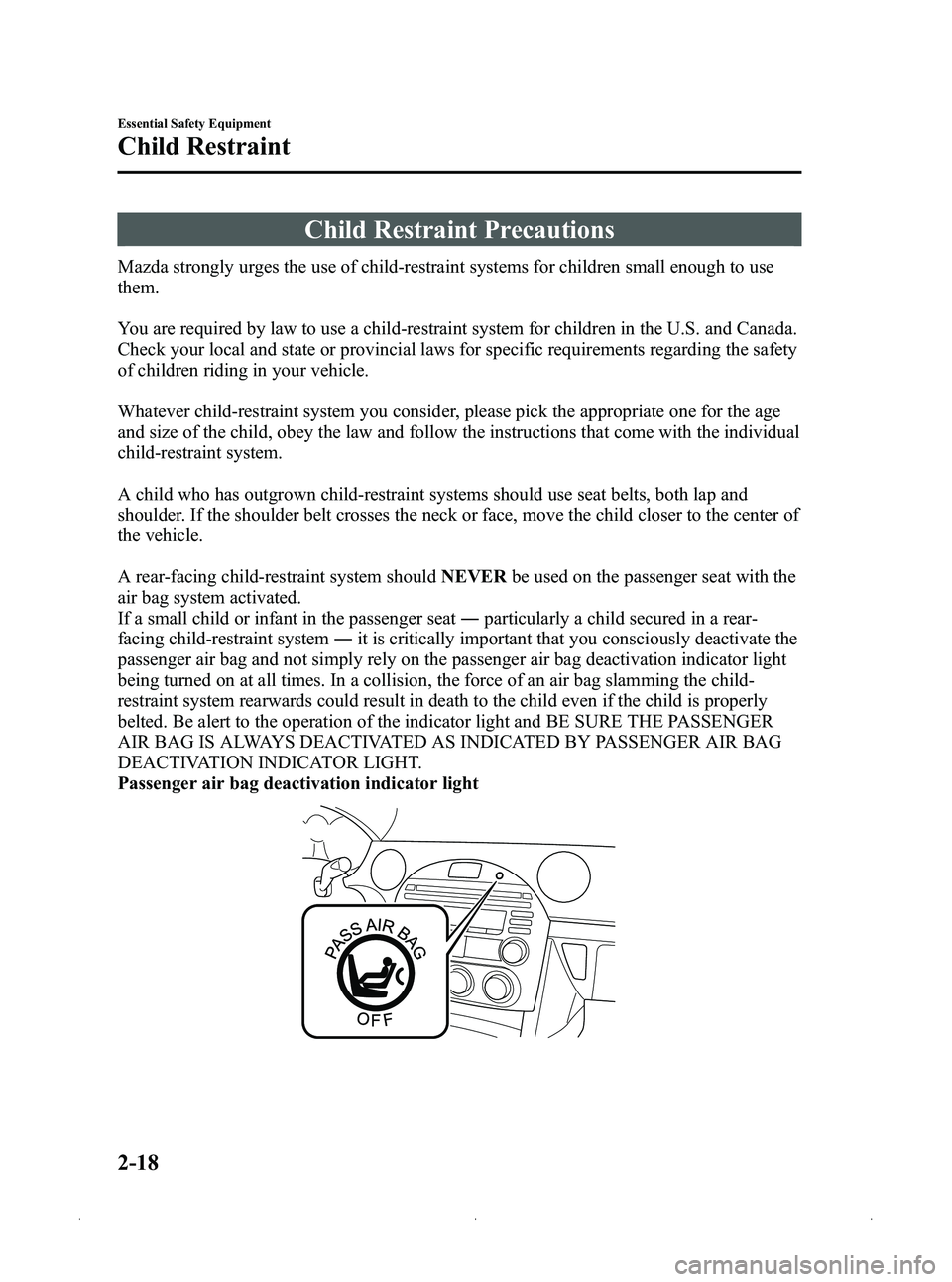
Black plate (30,1)
Child Restraint Precautions
Mazda strongly urges the use of child-restraint systems for children small enough to use
them.
You are required by law to use a child-restraint system for children in the U.S. and Canada.
Check your local and state or provincial laws for specific requirements regarding the safety
of children riding in your vehicle.
Whatever child-restraint system you consider, please pick the appropriate one for the age
and size of the child, obey the law and follow the instructions that come with the individual
child-restraint system.
A child who has outgrown child-restraint systems should use seat belts, both lap and
shoulder. If the shoulder belt crosses the neck or face, move the child closer to the center of
the vehicle.
A rear-facing child-restraint system shouldNEVERbe used on the passenger seat with the
air bag system activated.
If a small child or infant in the passenger seat ―particularly a child secured in a rear-
facing child-restraint system ―it is critically important that you consciously deactivate the
passenger air bag and not simply rely on the passenger air bag deactivation indicator light
being turned on at all times. In a collision, the force of an air bag slamming the child-
restraint system rearwards could result in death to the child even if the child is properly
belted. Be alert to the operation of the indicator light and BE SURE THE PASSENGER
AIR BAG IS ALWAYS DEACTIVATED AS INDICATED BY PASSENGER AIR BAG
DEACTIVATION INDICATOR LIGHT.
Passenger air bag deactivation indicator light
2-18
Essential Safety Equipment
Child Restraint
MX-5_8CC1-EA-11F_Edition2 Page30
Monday, July 18 2011 10:7 AM
Form No.8CC1-EA-11F
Page 31 of 456
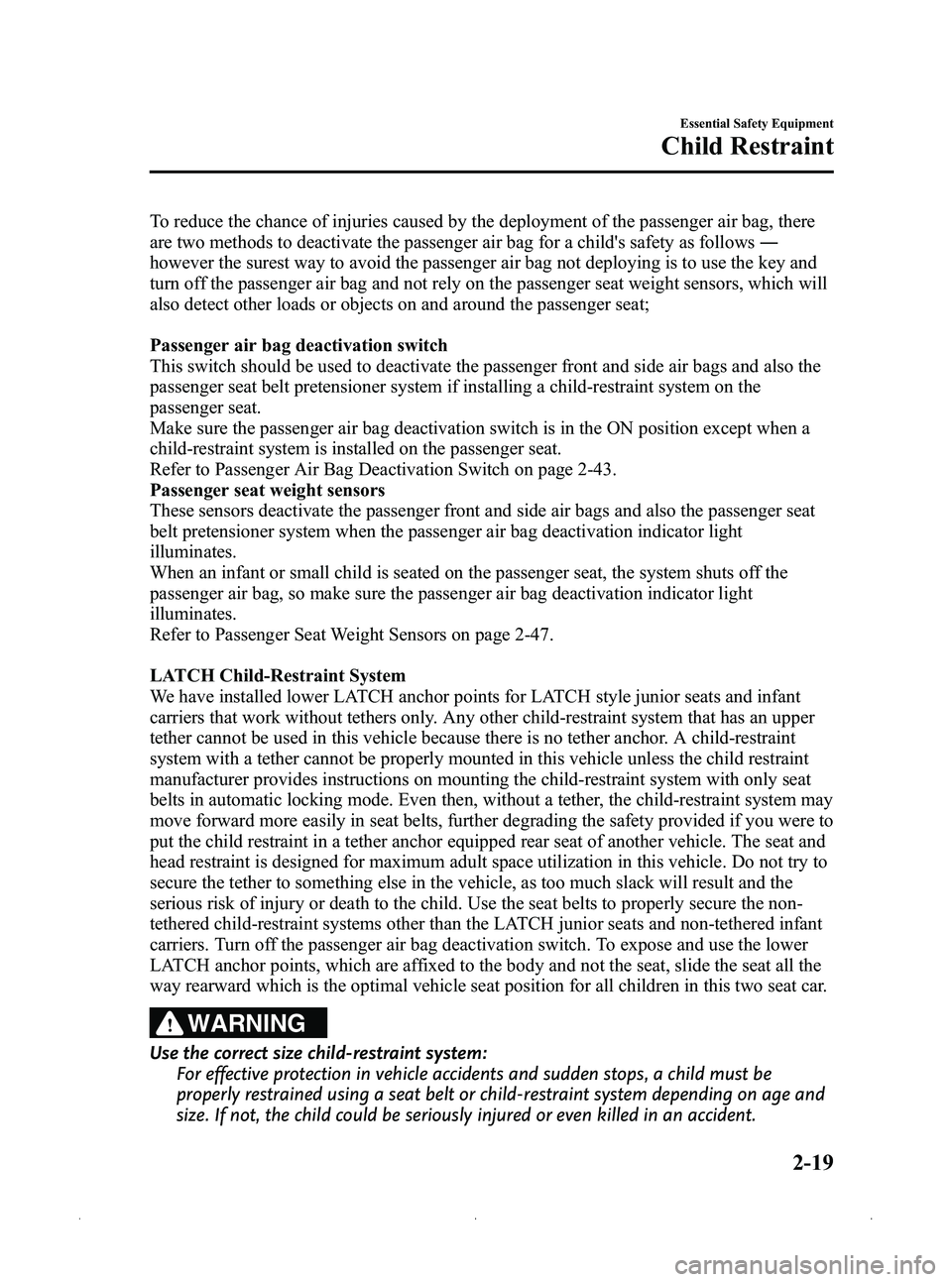
Black plate (31,1)
To reduce the chance of injuries caused by the deployment of the passenger air bag, there
are two methods to deactivate the passenger air bag for a child's safety as follows―
however the surest way to avoid the passenger air bag not deploying is to use the key and
turn off the passenger air bag and not rely on the passenger seat weight sensors, which will
also detect other loads or objects on and around the passenger seat;
Passenger air bag deactivation switch
This switch should be used to deactivate the passenger front and side air bags and also the
passenger seat belt pretensioner system if installing a child-restraint system on the
passenger seat.
Make sure the passenger air bag deactivation switch is in the ON position except when a
child-restraint system is installed on the passenger seat.
Refer to Passenger Air Bag Deactivation Switch on page 2-43.
Passenger seat weight sensors
These sensors deactivate the passenger front and side air bags and also the passenger seat
belt pretensioner system when the passenger air bag deactivation indicator light
illuminates.
When an infant or small child is seated on the passenger seat, the system shuts off the
passenger air bag, so make sure the passenger air bag deactivation indicator light
illuminates.
Refer to Passenger Seat Weight Sensors on page 2-47.
LATCH Child-Restraint System
We have installed lower LATCH anchor points for LATCH style junior seats and infant
carriers that work without tethers only. Any other child-restraint system that has an upper
tether cannot be used in this vehicle because there is no tether anchor. A child-restraint
system with a tether cannot be properly mounted in this vehicle unless the child restraint
manufacturer provides instructions on mounting the child-restraint system with only seat
belts in automatic locking mode. Even then, without a tether, the child-restraint system may
move forward more easily in seat belts, further degrading the safety provided if you were to
put the child restraint in a tether anchor equipped rear seat of another vehicle. The seat and
head restraint is designed for maximum adult space utilization in this vehicle. Do not try to
secure the tether to something else in the vehicle, as too much slack will result and the
serious risk of injury or death to the child. Use the seat belts to properly secure the non-
tethered child-restraint systems other than the LATCH junior seats and non-tethered infant
carriers. Turn off the passenger air bag deactivation switch. To expose and use the lower
LATCH anchor points, which are affixed to the body and not the seat, slide the seat all the
way rearward which is the optimal vehicle seat position for all children in this two seat car.
WARNING
Use the correct size child-restraint system: For effective protection in vehicle accidents and sudden stops, a child must be
properly restrained using a seat belt or child-restraint system depending on age and
size. If not, the child could be seriously injured or even killed in an accident.
Essential Safety Equipment
Child Restraint
2-19
MX-5_8CC1-EA-11F_Edition2 Page31
Monday, July 18 2011 10:7 AM
Form No.8CC1-EA-11F
Page 32 of 456
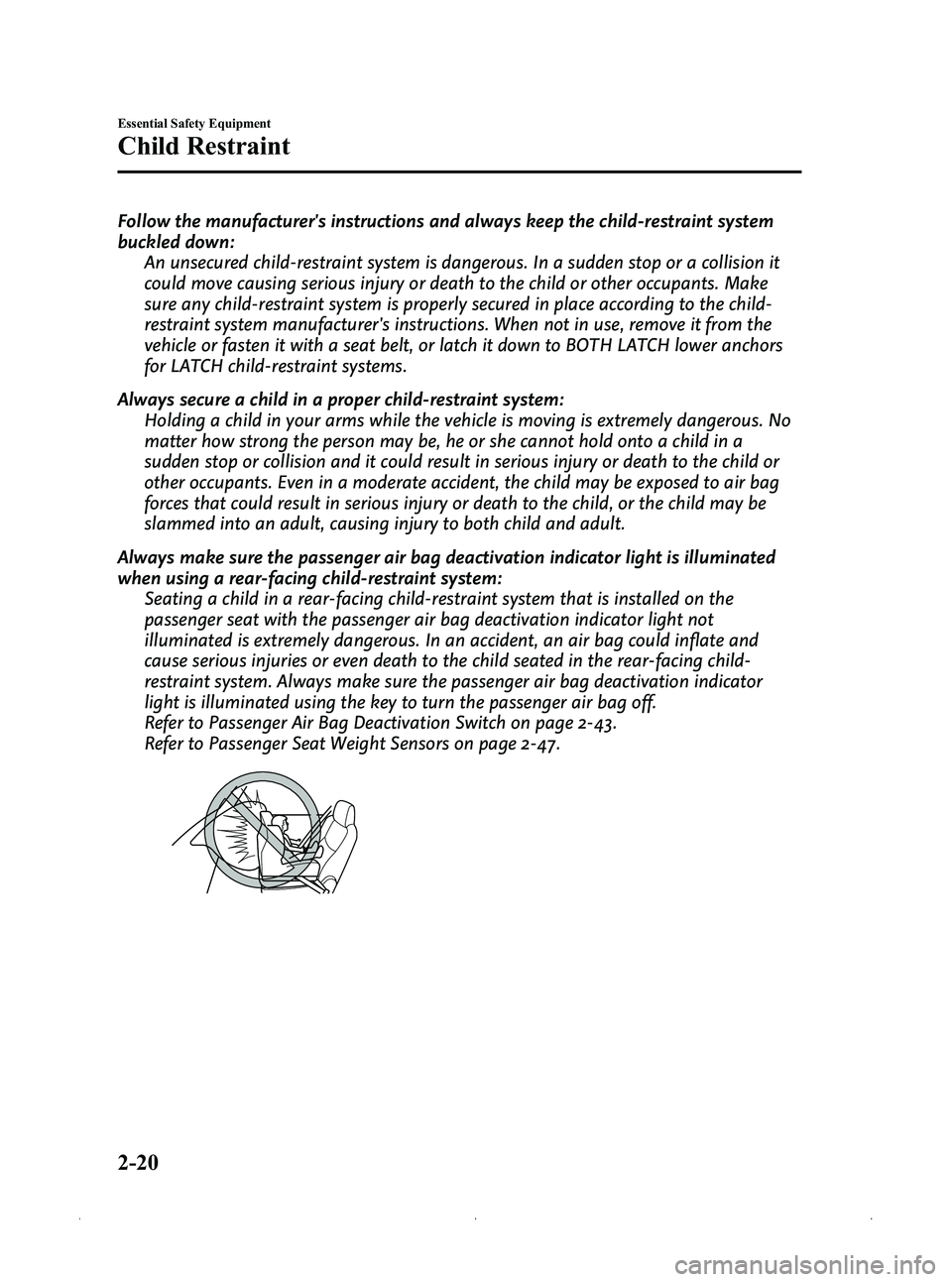
Black plate (32,1)
Follow the manufacturer's instructions and always keep the child-restraint system
buckled down:An unsecured child-restraint system is dangerous. In a sudden stop or a collision it
could move causing serious injury or death to the child or other occupants. Make
sure any child-restraint system is properly secured in place according to the child-
restraint system manufacturer's instructions. When not in use, remove it from the
vehicle or fasten it with a seat belt, or latch it down to BOTH LATCH lower anchors
for LATCH child-restraint systems.
Always secure a child in a proper child-restraint system: Holding a child in your arms while the vehicle is moving is extremely dangerous. No
matter how strong the person may be, he or she cannot hold onto a child in a
sudden stop or collision and it could result in serious injury or death to the child or
other occupants. Even in a moderate accident, the child may be exposed to air bag
forces that could result in serious injury or death to the child, or the child may be
slammed into an adult, causing injury to both child and adult.
Always make sure the passenger air bag deactivation indicator light is illuminated
when using a rear-facing child-restraint system: Seating a child in a rear-facing child-restraint system that is installed on the
passenger seat with the passenger air bag deactivation indicator light not
illuminated is extremely dangerous. In an accident, an air bag could inflate and
cause serious injuries or even death to the child seated in the rear-facing child-
restraint system. Always make sure the passenger air bag deactivation indicator
light is illuminated using the key to turn the passenger air bag off.
Refer to Passenger Air Bag Deactivation Switch on page 2-43.
Refer to Passenger Seat Weight Sensors on page 2-47.
2-20
Essential Safety Equipment
Child Restraint
MX-5_8CC1-EA-11F_Edition2 Page32
Monday, July 18 2011 10:7 AM
Form No.8CC1-EA-11F
Page 33 of 456
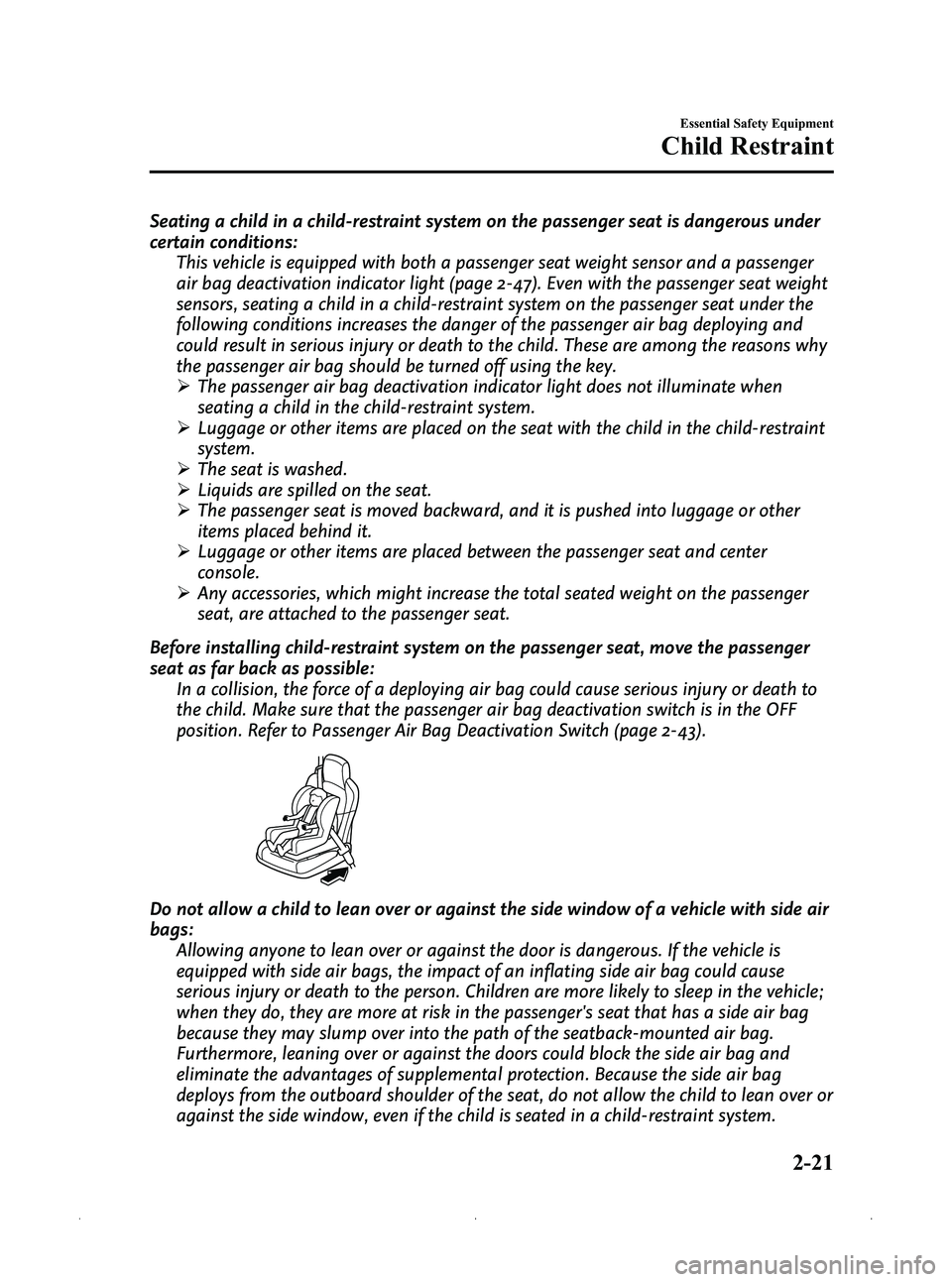
Black plate (33,1)
Seating a child in a child-restraint system on the passenger seat is dangerous under
certain conditions:This vehicle is equipped with both a passenger seat weight sensor and a passenger
air bag deactivation indicator light (page 2-47). Even with the passenger seat weight
sensors, seating a child in a child-restraint system on the passenger seat under the
following conditions increases the danger of the passenger air bag deploying and
could result in serious injury or death to the child. These are among the reasons why
the passenger air bag should be turned off using the key.
ØThe passenger air bag deactivation indicator light does not illuminate when
seating a child in the child-restraint system.
Ø Luggage or other items are placed on the seat with the child in the child-restraint
system.
Ø The seat is washed.
Ø Liquids are spilled on the seat.
Ø The passenger seat is moved backward, and it is pushed into luggage or other
items placed behind it.
Ø Luggage or other items are placed between the passenger seat and center
console.
Ø Any accessories, which might increase the total seated weight on the passenger
seat, are attached to the passenger seat.
Before installing child-restraint system on the passenger seat, move the passenger
seat as far back as possible: In a collision, the force of a deploying air bag could cause serious injury or death to
the child. Make sure that the passenger air bag deactivation switch is in the OFF
position. Refer to Passenger Air Bag Deactivation Switch (page 2-43).
Do not allow a child to lean over or against the side window of a vehicle with side air
bags:Allowing anyone to lean over or against the door is dangerous. If the vehicle is
equipped with side air bags, the impact of an inflating side air bag could cause
serious injury or death to the person. Children are more likely to sleep in the vehicle;
when they do, they are more at risk in the passenger's seat that has a side air bag
because they may slump over into the path of the seatback-mounted air bag.
Furthermore, leaning over or against the doors could block the side air bag and
eliminate the advantages of supplemental protection. Because the side air bag
deploys from the outboard shoulder of the seat, do not allow the child to lean over or
against the side window, even if the child is seated in a child-restraint system.
Essential Safety Equipment
Child Restraint
2-21
MX-5_8CC1-EA-11F_Edition2 Page33
Monday, July 18 2011 10:7 AM
Form No.8CC1-EA-11F
Page 34 of 456
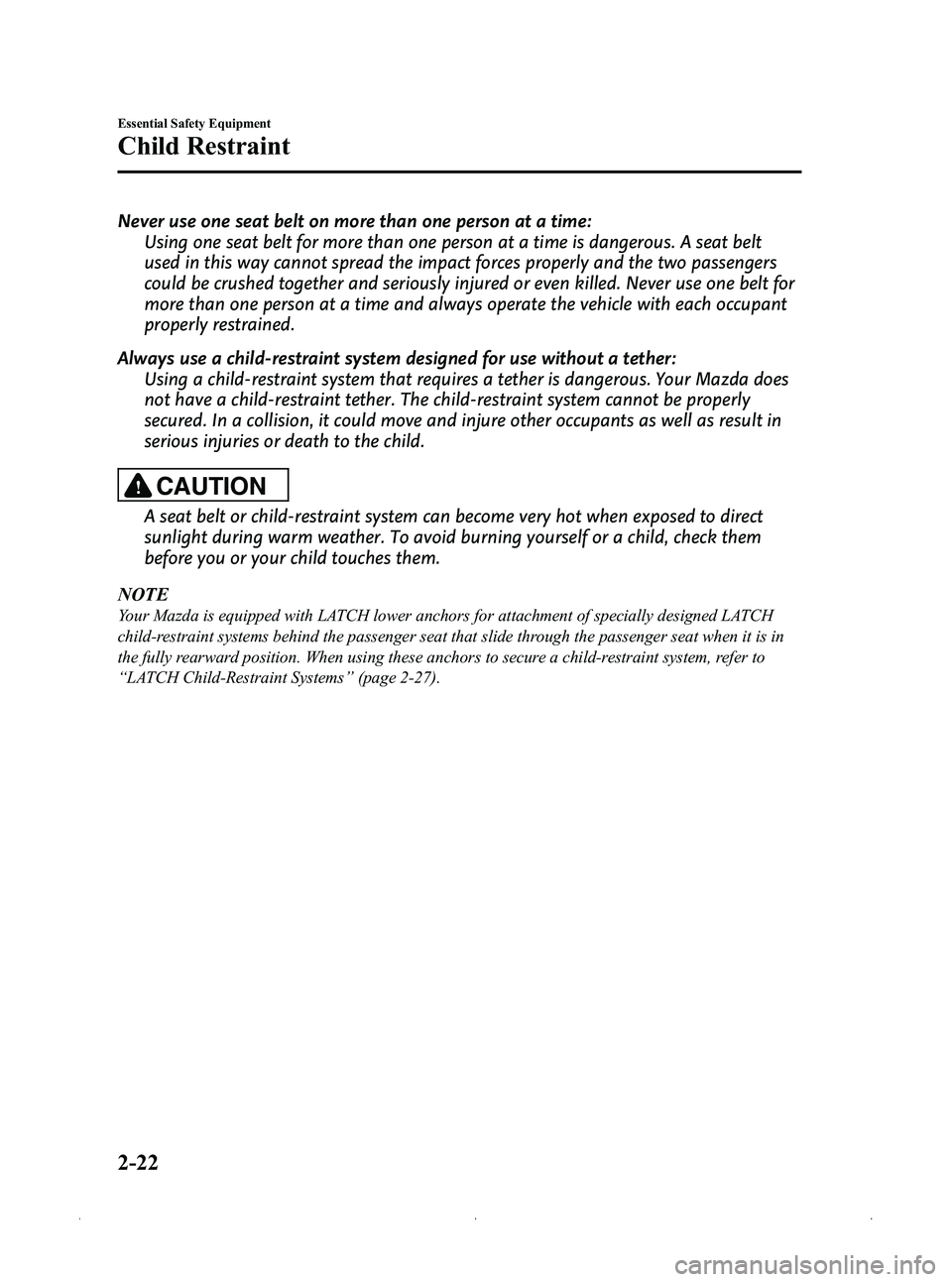
Black plate (34,1)
Never use one seat belt on more than one person at a time:Using one seat belt for more than one person at a time is dangerous. A seat belt
used in this way cannot spread the impact forces properly and the two passengers
could be crushed together and seriously injured or even killed. Never use one belt for
more than one person at a time and always operate the vehicle with each occupant
properly restrained.
Always use a child-restraint system designed for use without a tether: Using a child-restraint system that requires a tether is dangerous. Your Mazda does
not have a child-restraint tether. The child-restraint system cannot be properly
secured. In a collision, it could move and injure other occupants as well as result in
serious injuries or death to the child.
CAUTION
A seat belt or child-restraint system can become very hot when exposed to direct
sunlight during warm weather. To avoid burning yourself or a child, check them
before you or your child touches them.
NOTE
Your Mazda is equipped with LATCH lower anchors for attachment of specially designed LATCH
child-restraint systems behind the passenger seat that slide through the passenger seat when it is in
the fully rearward position. When using these anchors to secure a child-restraint system, refer to
“ LATCH Child-Restraint Systems ”(page 2-27).
2-22
Essential Safety Equipment
Child Restraint
MX-5_8CC1-EA-11F_Edition2 Page34
Monday, July 18 2011 10:7 AM
Form No.8CC1-EA-11F